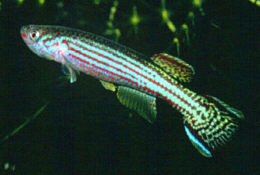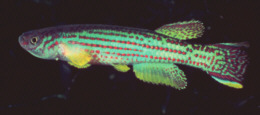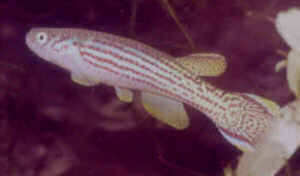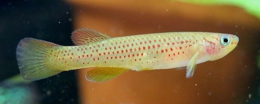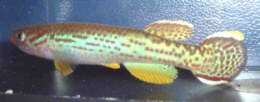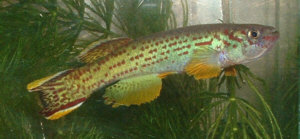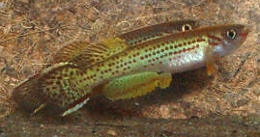Fundulopanchax oeseri (Schmidt 1928)
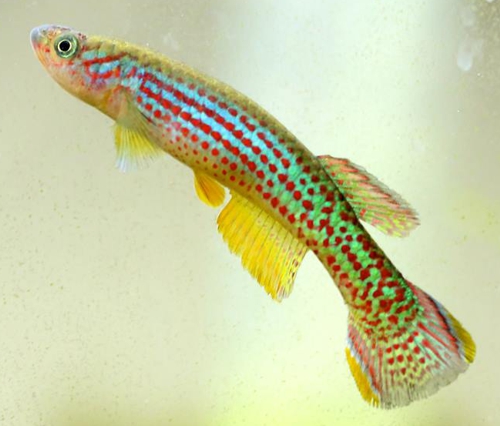
Bioko Island
Photo courtesy of Michael Pidwirny
| Meaning of Name |
After Dr. Richard Öser, the original collector. |
||||||||||
| First Description |
Schmidt H. 1928. Über zwei neueimportierte Fische. Das Aquarium (Berlin) 2: p 165-166, figure. |
||||||||||
| Size |
6 cm |
||||||||||
| Meristics |
D = 10-12, A = 14-16, ll = 31-33 (Scheel 1968, A.santaisabellae) |
||||||||||
| Karyotype |
n = 20, A = 34 (Scheel 1968) |
||||||||||
| Sub-Genus |
|
||||||||||
| Group |
oeseri |
||||||||||
| Synonyms |
|
||||||||||
Populations
|
GS 88 / 2 - Formerly just known as GS 2. Unknown collection location. Collected by Gresens Schwoiser V, & Horst in January 1988.
|
||||||||||
| Type Locality |
Given as 'West Africa'. The exact location is unknown as the types were aquarium specimens. |
||||||||||
| Distribution |
Restricted to the island of Fernando Po (presently called Bioko Island) where they inhabit the northern end of the island. |
||||||||||
| Habitat |
Rainforest swampy areas, small streams, brooks & coastal rivers. |
||||||||||
| Distinguishing Characteristics | Clear
anal fin which can be orange, combined with rows of spots along flanks. Easily seperated from marmoratus which has an anal with submarginal banding. Also, scheeli can have a clear orange anal fin but lacks the rows of spots as seen on oeseri. |
||||||||||
| Colour/Pattern Variability | Low | ||||||||||
| History |
Arnold & Ahl, in 1936 gave a short description of oeseri from fish collected from the eastern area of the Niger Delta & Old Calabar which were imported into Germany in 1928. These were named Aphyosemion oeseri E.Ahl, 1928. In 1931 Beyer confirmed the area of origin for these fish & stated that they were collected by Dr. Öser. He brought 2 males according to Grelk (1 according to Öser) back to Berlin, Germany alive from this collection of summer 1928. In the autumn of that year Platy-Tischrunde, a German importer, received more individuals. In the summer of 1929 more live fish were imported in a collection from Port Harcourt by Wandsbeker. He reported oeseri, vexillifer & calliurum to be rather similar. In 1928 Öser published a detailed report on his collecting trip in 1928. His area of collection was given as 'West Africa', although he gave no indication that he had collected fishes in Nigeria or Cameroon. He did give a detailed report on collecting sexfasciatus & an Aphyosemion sp. near to Santa Isabel on the island of Fernando Po. Although Arnold & Ahl put a description together in 1936 fish were used also from the Platy-Tischrunde imports & the collection by Wandsbeker. Ahl's brief description in 1928 was not considered to be sufficient to warrant the original description. Collected by J.J.Scheel in 1968 from a swamp at the head of a brook which flowed into the Rio Consul. Scheel was trying to retrace the steps of Öser in 1928 but had great difficulty as the area had changed. Fish collected from this trip were distributed to various aquarists as Aphyosemion santaisabellae. Scheel could not find a scientific description
for Panchax oeseri & named the
fish Aphyosemion santaisabellae
in 1968. Four years this was ruled to be a breach of the rules of Zoological
Nomenclature as reported by Dr.Trewavas. She cited a description by
H.Schmidt in DAS Aquarium, October 1928 as the original description
of the sp. Schmidt's description of 1928 is recognised as the original
description as he was the first to put together a description of colouration
& markings. It was interesting to note that this photograph differed
slightly from the fish Scheel collected. Scheel returned to Fernando Po in 1969 &
collected them again but this time on the opposite side of the Rio Consul
drainage in a seperate river which was seperated from the main Rio Consul.
It was considered that these rivers may have been joined some 10,000
years earlier & reproductive isolation may have resulted in differing
fish. These were referred to as A.aff.santaisabellae
but none survived the trip home. There first recorded distributed in the BKA is in 1970. These were then known as A.santaisabellae. |
||||||||||
| Breeding Notes |
A fairly easy species to breed (at least they caused me no problems) laying eggs mainly in top mops. Water incubation takes about 18-21 days. They are quite slow growing taking around 6-7 months to reach sexual maturity. Sexing out may be reached at about 5 months but these young fish are not ready to breed at this age. In BKA newsletter77, January 1972 a report outlining
experiments with dry storage. Eggs were soaked in a solution of Malachite
Green for 24 hours & placed in peat fibre, the consistency of which
was described as being 'dampish not wet'. The eggs were incubated for
a period of 'not less than 6 weeks'. The hatching container had 6"
of water depth, water temperature 70-72°F, pH 6·6-6·8,
DH 2-7. Hatching occurred in a few hours with all eggs hatching out
within a 6 hour period. A breeding report can be found in BKA newsletter No. 89, January 1973 concerning dry storage methods. Eggs were collected & placed in peat for about 8 weeks. This was wet in water at 70°F. Hatching is reported to have occurred after 4 hours with a 92% hatch rate. Observations found these fry to be larger & more vigourous than water incubated eggs. There were no losses in bringing them on to adulthood. An article by Roloff in the BKA newsletter No.91, March 1973 gives a breeding report. He considered them a prolific spawner laying eggs on fine leaved plants near the bottom of the tank. Java moss was used on a sand substrate to good effect. Roloff collected the eggs & water incubated them in a seperate container. He did not recommend dry storage with this sp. At a temperature of 22-24°C the eggs hatched in 2-3 weeks. First food was newly hatched brine shrimp. Young grew on without problems. Fred Wright in the above newsletter stated that young grown with there parents grew much larger. Removing young fish before they reached three quarters of an inch was fatal. Dry storage was tried by various members of the BKA at this time but met with little success. |
||||||||||
| Diameter of Egg | |||||||||||
| Remarks |
This species is an expert jumper. Now considered in great danger. |
